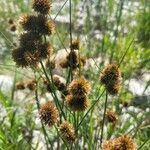Stems stout, rigid, erect, 4–10 dm, arising singly from the nodes of cord-like rhizomes that are evidently tuberous-thickened at intervals; cauline lvs 2–5, the blades terete, septate, usually divaricate, 1–3 dm × 1–3 mm; margins of the sheaths pale and scarious, prolonged into scarious auricles 2–5 mm; infl usually dense, 2–4 cm, occasionally open and to 8 cm, with 2–10(–20) globose, 25–100-fld heads 10–15 mm thick; fls eprophyllate; tep linear-subulate, tapering to very slender, rigid points, the sep 3.5–5.5 mm, the pet evidently shorter; stamens 6; fr 4.5–5.7 mm, otherwise as in no. 31 [Juncus nodosus L.]; 2n=40. Wet sunny places or shallow standing water, especially on prairies; N.Y. and s. Ont. to Ky. and Tex., w. to Sask., Wash., Calif., and n. Mex.; also at scattered stations e. to Me. and N.J. and in the Gulf states.

